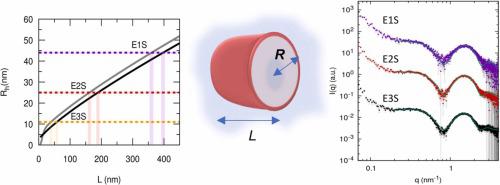当前位置:
X-MOL 学术
›
Colloids Surf. A Physicochem. Eng. Aspects
›
论文详情
Our official English website, www.x-mol.net, welcomes your feedback! (Note: you will need to create a separate account there.)
Sodium lauryl ether sulfates, pivotal surfactants for formulations: Rationalization of their assembly properties
Colloids and Surfaces A: Physicochemical and Engineering Aspects ( IF 4.9 ) Pub Date : 2024-02-03 , DOI: 10.1016/j.colsurfa.2024.133375 Rosaceleste Zumpano , Alessandra Del Giudice , Stefano Resta , Andrea D’Annibale , Fabio Sciubba , Francesco Mura , Giacomo Parisi , Maria Chiara di Gregorio , Luciano Galantini
Colloids and Surfaces A: Physicochemical and Engineering Aspects ( IF 4.9 ) Pub Date : 2024-02-03 , DOI: 10.1016/j.colsurfa.2024.133375 Rosaceleste Zumpano , Alessandra Del Giudice , Stefano Resta , Andrea D’Annibale , Fabio Sciubba , Francesco Mura , Giacomo Parisi , Maria Chiara di Gregorio , Luciano Galantini

|
Sodium lauryl ether sulfates (SLES) are a class of surfactants, among the most used in the formulations of healthcare products. Although largely used in industry, literature studies are hereto completely missing of the characterization of some species, as sodium lauryl triether sulfates (), and of the effect of several assembly parameters, as temperature. Moreover, drastic disparity of assembly performance subsists among laboratory synthesized and industrial raw SLES, generating problems in the real-world applications of formulations design. We report on the self-assembly analysis of industrial grade sodium lauryl monoether sulfate (), sodium lauryl diether sulfate () and laboratory synthesized . The surfactants were studied in a large range of NaCl concentrations (0.1–1 M NaCl) and as function of the temperature by crossing Surface Tension, Small-Angle X-ray Scattering and Dynamic Light Scattering measurements. Such analysis enabled to establish systematic relationship between the molecular structure and assembly properties of the surfactants and to define size and morphologies variations of the aggregates. We observed that i) core-shell spherical aggregates evolve towards elongated core-shell structures upon addition of NaCl, ii) the elongation is higher the lower the number of the ether groups iii) is greatly stable in the analyzed temperature range (20 °C - 60 °C), iv) the industrial grade exhibit a minimum of the surface tension and an anticipated self-assembly as a function of concentration, probably due to the presence of hydrophobic impurities. Impurities are also detected by DLS in unfiltered samples of the industrial grade as large particles.
中文翻译:

十二烷基醚硫酸钠,配方中的关键表面活性剂:其组装特性的合理化
十二烷基醚硫酸钠 (SLES) 是一类表面活性剂,是保健产品配方中最常用的表面活性剂。尽管在工业中得到广泛应用,但文献研究迄今为止完全缺少某些物种的表征,例如十二烷基三醚硫酸钠(),以及几个组装参数(例如温度)的影响。此外,实验室合成的 SLES 和工业原始 SLES 之间存在组装性能的巨大差异,这在配方设计的实际应用中产生了问题。我们报告了工业级十二烷基单醚硫酸钠 ()、十二烷基二醚硫酸钠 () 和实验室合成的自组装分析。通过交叉表面张力、小角 X 射线散射和动态光散射测量,在大范围的 NaCl 浓度(0.1–1 M NaCl)下研究表面活性剂与温度的函数关系。这种分析能够在表面活性剂的分子结构和组装特性之间建立系统关系,并确定聚集体的尺寸和形态变化。我们观察到,i) 添加 NaCl 后,核-壳球形聚集体会演化为伸长的核-壳结构,ii) 醚基数量越少,伸长率越高 iii) 在分析的温度范围内(20 °C)非常稳定- 60 °C), iv) 工业级表现出最小的表面张力和预期的作为浓度函数的自组装,可能是由于疏水性杂质的存在。 DLS 还可以在未过滤的工业级样品中检测到大颗粒杂质。
更新日期:2024-02-03
中文翻译:

十二烷基醚硫酸钠,配方中的关键表面活性剂:其组装特性的合理化
十二烷基醚硫酸钠 (SLES) 是一类表面活性剂,是保健产品配方中最常用的表面活性剂。尽管在工业中得到广泛应用,但文献研究迄今为止完全缺少某些物种的表征,例如十二烷基三醚硫酸钠(),以及几个组装参数(例如温度)的影响。此外,实验室合成的 SLES 和工业原始 SLES 之间存在组装性能的巨大差异,这在配方设计的实际应用中产生了问题。我们报告了工业级十二烷基单醚硫酸钠 ()、十二烷基二醚硫酸钠 () 和实验室合成的自组装分析。通过交叉表面张力、小角 X 射线散射和动态光散射测量,在大范围的 NaCl 浓度(0.1–1 M NaCl)下研究表面活性剂与温度的函数关系。这种分析能够在表面活性剂的分子结构和组装特性之间建立系统关系,并确定聚集体的尺寸和形态变化。我们观察到,i) 添加 NaCl 后,核-壳球形聚集体会演化为伸长的核-壳结构,ii) 醚基数量越少,伸长率越高 iii) 在分析的温度范围内(20 °C)非常稳定- 60 °C), iv) 工业级表现出最小的表面张力和预期的作为浓度函数的自组装,可能是由于疏水性杂质的存在。 DLS 还可以在未过滤的工业级样品中检测到大颗粒杂质。








































 京公网安备 11010802027423号
京公网安备 11010802027423号